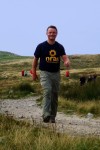
True stories
Nicole Caudill’s diagnosis of fibromyalgia devastated her life – but a pain clinic and the support of family and friends have helped her turn it back around
 I am 38 years old and have lived with fibromyalgia for six years. I have suffered from depression and anxiety the majority of my life which have been controlled through medication. But while at work in 2008 I started noticing sharp pains shooting down the back of my skull and all the way down my back. I had a very stressful job and just thought this pain was due to stress. I saw my psychiatrist who prescribed more pills in the hope of easing the stress and pain.
I am 38 years old and have lived with fibromyalgia for six years. I have suffered from depression and anxiety the majority of my life which have been controlled through medication. But while at work in 2008 I started noticing sharp pains shooting down the back of my skull and all the way down my back. I had a very stressful job and just thought this pain was due to stress. I saw my psychiatrist who prescribed more pills in the hope of easing the stress and pain.
The year 2008 was the hardest of my life. As well as going through a lot of personal issues I had a stressful career as a social worker. I now know the amount of stress I was under caused trauma to my central nervous system, which resulted in fibromyalgia. My body was giving me so many signs that I needed to take care of myself but unfortunately, this disease is the aftermath of not listening to my body. Continue reading
Stuart Blake completed a gruelling Ironman challenge after his diagnosis with ankylosing spondylitis. His inspiration? Winners are not people who never fail, but people who never quit
 I live in Essex with my wife and three children and was a full-time London cab driver until my diagnosis of ankylosing spondylitis in August 2011. Since then I have had to reduce my hours to part-time and my wife resumed full-time employment due to the severity of my condition.
I live in Essex with my wife and three children and was a full-time London cab driver until my diagnosis of ankylosing spondylitis in August 2011. Since then I have had to reduce my hours to part-time and my wife resumed full-time employment due to the severity of my condition.
A long journey to diagnosis
In 1999 I began suffering from a stabbing pain in my left buttock, which gradually got worse. I found I was no longer able to run, which resulted in me having to give up playing football. I loved the sport and missed the dressing room banter. I was in pain for over seven years and after numerous MRI scans, one showed I had a slipped disc. The surgery took place in 2000 and I hoped it would be the end of my misery. Unfortunately I was wrong. Continue reading
“Fly on the strength of your own wings” – the mantra that has kept Dina Neils running
 I was diagnosed with rheumatoid arthritis when I was 18 years old and was told by my doctor, “You will never run again and you will be in a wheelchair by the time you’re in your mid 20s.”
I was diagnosed with rheumatoid arthritis when I was 18 years old and was told by my doctor, “You will never run again and you will be in a wheelchair by the time you’re in your mid 20s.”
Not willing to accept that diagnosis, I told the doctor that she was wrong and walked out. For 12 years I battled rheumatoid arthritis, an autoimmune disease with no cure that causes chronic pain and inflammation affecting joints and organs throughout the body. Continue reading
Top NHS consultant takes on gruelling challenges for arthritis charities
 Dr Chris Deighton, the outgoing President of the British Society for Rheumatology, will be walking the 100k from London to Brighton on 24 and 25 May to raise money for the National Ankylosing Spondylitis Society (NASS) and then competing in the “World’s greatest half marathon,” the Great North Run on 7 September for the National Rheumatoid Arthritis Society (NRAS).
Dr Chris Deighton, the outgoing President of the British Society for Rheumatology, will be walking the 100k from London to Brighton on 24 and 25 May to raise money for the National Ankylosing Spondylitis Society (NASS) and then competing in the “World’s greatest half marathon,” the Great North Run on 7 September for the National Rheumatoid Arthritis Society (NRAS).
“Inflammatory arthritis does not get the publicity it deserves,” Chris says. “My aim is to raise it up the NHS agenda and improve access to the resources that are needed to provide high quality multidisciplinary services. This is my chance to increase the profile of the disease and raise some money for two excellent organisations like NASS and NRAS, who do fantastic work in supporting patients and raising awareness of these conditions. Continue reading
My first symptom was when my back went at the age of 32 years. Ann’s journey with alkaptonuria
Sorsha Roberts from the AKU Society speaks to Ann about her life with rare disease, alkaptonuria (AKU)
Alkaptonuria (AKU) is a rare genetic disease that causes severe, early onset osteoarthritis. AKU is also known as black bone disease or black urine disease, as these are both symptoms. It is a degenerative and often very painful disease which is caused by a build-up of homeogentistic acid in the body. Because it is so rare, diagnosis can be a long and difficult process.
At the AKU Society we aim to identify patients and bring them together, offering advice, support and even medical assessment at our National AKU Centre in Liverpool. Ann is one of these patients. I spoke to her to try and understand her experience living with the disease.
“I was in agony”
Ann was very active whilst working as a retail manager and running around on the shop floor, but after being made redundant she became a full time student. With so much sitting down and studying, her back seized.
“My first symptom was when my back went at the age of 32 years.”
After going to see a chiropractor she was told she had severe osteoarthritis in her lower spine. This is very unusual at such a young age, but Ann was unable to get her doctor to pursue it any further, and was sent away with painkillers.
“I was in a lot of pain. I was unable to lift heavy items which was problematic as I had a young daughter at the time. I couldn’t do as much as I used to and I became very cautious.”
Ann remembers one night where she got stuck in the bath due to her arthritis, “I could hardly move. I lived on my own at the time and I had to flip myself over the side of the bath. It was really scary.”
Misdiagnosis
This misdiagnosis was the first of three. Ann was next diagnosed with a blood disorder in May 2007, and sent for blood tests. When Ann had her first knee replacement five months later the bones of her joint were blackened, and she was diagnosed with pigmented villonodular synovitis (PVNS), a rare disease that effects knee and hip joints. She was told the knee replacement would solve many of the painful joint problems, but Ann’s pain did not go away. By the time she was sent for a revision, her shoulders were feeling painful too.
Ann says she found that GPs don’t have much time for their patients, and they are not experts on everything.
“Being dismissed was really hard for a long time. And really painful. But I knew something was wrong. I think we instinctively know our own bodies.”
Ann was finally diagnosed correctly at the age of 49 years after moving and changing GP. After years of not being able to understand her disease she describes it as a complete 360-degree turnaround. “It was a huge relief once I knew they had got the diagnosis right. Before I felt isolated and doubted myself. After my diagnosis I felt I was being taken seriously”
“There’s nothing bad to say about the AKU Society!”
Ann quickly got in touch with the AKU Society and was invited to the National AKU Centre in Liverpool for a full three-day assessment. Ann says this really helped her understand the progression of her disease.
When I asked Ann how the AKU Society had benefited her she said: “The peer support is incredible”.
The AKU Society has put her in contact with patients across the world through social media, patient conferences, and online communities such as PatientsLikeMe. Ann particularly recommends Patients Know Best, which allows patients to record and monitor their health records online, and securely exchange information with health professionals.
Ann now helps with teaching at Bristol Royal Infirmary every few months. The students have to take her medical history and try to provide her with a diagnosis.
“None of them have ever diagnosed me correctly!” she says.
The students then get to examine her and she teaches them about AKU. Ann explains that she loves feeling that she is helping.
“The students say they remember the experience with me a lot better than if they had just learnt about AKU from a book.”
Overall Ann has now had six joint replacement operations, and open heart surgery to remove a benign tumour that developed as a result of AKU. She says the joint replacements after her diagnosis have been more successful than those before. A researcher now attends her operations to collect tissue samples for AKU research, and Ann told me, “I have donated my body for research in to AKU after I am gone.”
![]() Click here for more on the AKU Society.
Click here for more on the AKU Society.

